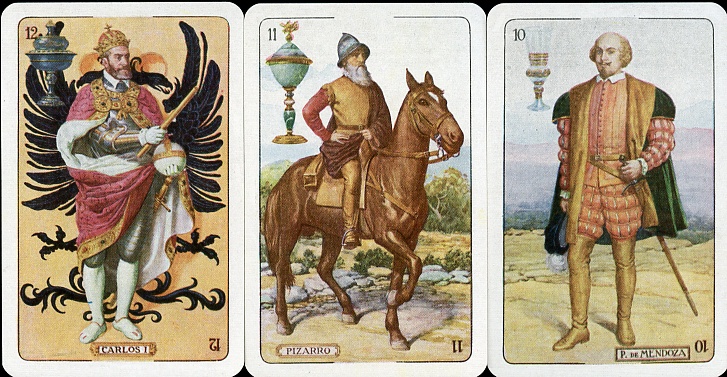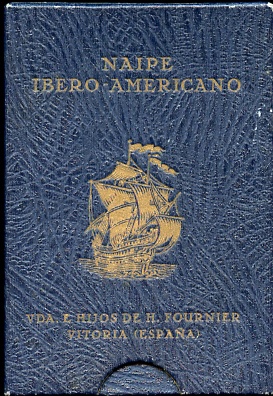October
2019
 |
This is
one of the few decks that I have acquired lately. We already have the
later edition of this deck, but I had found a first edition on eBay and
thought it would bring a nice exchange within our collection. I don't
know why, but I had always expected the first edition to be printed in
chromolithography. So it was a bit of a disappointment to find that this
first edition was already printed in offset. Still, I like the detailed
designs a lot. |
The deck was
exclusively printed and published for the Universal Exposition in Sevilla and
Barcelona in 1929. The deck is titled "Naipe Historico Ibero Americano"
and was made by Fournier. Not Heraclio, who had died in 1916, but by his widow
and sons, the "Viuda e Hijos de Heraclio Fournier". The deck deals
with the Spanish conquests in South America. Three suits are dedicated to the
Spanish side and only one to the local tribes and people, but in my opinion that
suit is the most exciting one. The deck was designed by L. Palao (see the 7
of clubs).
The courts show the
leading figures of both sides in this conquest, but the illustrations on the pip
cards are beautiful enough to take a look at too. So click any of the aces to
see them. There's a short description of each of the courtly figures and other
cards in the accompanying leaflet, but my Spanish isn't well enough to translate
them. However, nowadays there's Wikipedia and with their help I created the
following short descriptions.
|

|
|
- Motezuma (c1466 - 1520) is one of the many variations of his
name, but they all refer to the leader of the Aztec people, who ruled
Tenochtitlan, the capital of his empire, from 1502 until 1520, when he
was killed.
|
|
- Atahualpa (c1502 - 1533) was the last Inca emperor. His reign was
only very short, from 1532 - 1533, but after his death the Inca empire
began to disintegrate.
|
|
- Caonabo was a chieftain of the Taino people, who inhabited
Hispaniola when Columbus landed there in 1492.
|
The Aztec empire's
territory was mainly located in central Mexico, the Inca empire's territory was
much larger and stretched along the east coast from Peru to a large part of
Chili. The Taino people lived across the Caribbean, on Cuba, Puerto Rico, the
Bahamas, Jamaica and Hispaniola, which is now divided into Haiti and the
Dominican Republic. It all started there when Christopher Columbus landed on
several islands during his first three voyages, but it wasn't until his fourth
journey that he embarked in Central America. His role is honored by representing
his face and name on the ace of coins.
|

|
|
- Fernando (Ferdinand) V (1452 - 1516) got this title when he
married Isabel of Castile and became King of Castile (de jure uxoris)
from 1474 - 1504. But he's also known as Ferdinand II in his capacity of
King of Aragon from 1479 until 1516 and Ferdinand III as King of Naples
from 1504 until 1516.
|
|
- Hernan Cortes (1485 - 1547) was a conquistador who caused the
fall of the Aztec empire and brought the mainland of Mexico under the
reign of the King of Castile in the early 16th century.
|
|
- Martin Alonzo Pinzon was captain of the Pinta, his brother of the
Nina, the caravels that accompanied the Pinta of Christopher Columbus on
his first voyage. He was responsible for recruiting most of the crew for
the three ships.
|
Click
any ace to see all the pip cards.
|

|
|
- Carlos (Charles) I (1500 - 1558) was the title that he got when
he was King of Castile and Aragon from 1516 until 1556, but he's better
known as Charles V, Holy Roman Emperor from 1519 until 1556.
|
|
- Pizarro (c1471/76 - 1541) was the conquistador who led the
Spanish conquest of Peru, a large part of the Inca empire. He captured
and killed Atahualpa (see above)
|
|
- Pedro de Mendoza was a Spanish nobleman and protégée of Charles
I, who set sail for the Rio Plata in 1529 as conquistador and founded
Buenos Aires in 1536.
|
|

|
|
- Felipe (Philip) II (1527 -1598) was King of Spain (Castile,
Aragon, Navarre) from 1556 until 1598.
|
|
- Miguel Lopez de Legazpi (1502 - 1572) sailed in 1564 from the new
world (Mexico) across the Pacific ocean and brought several islands,
including the Philippines, under Spanish rule.
|
|
- Magallanes (c1480 - 1521) was the first explorer in the East
Indies. He was killed on the Philippines during the battle of Mactan. He
had already found his way to Southeast Asia, traveling east, and now he
reached almost the same countries by traveling west.
|
The deck consists
of 40 cards and an extra (title) card.
It comes with an accompanying leaflet in Spanish, in which all the cards get a
short explanation.
The deck comes in a two-piece sliding box, with gold printed lettering and
illustration.
The back design is explained on a single, loose piece of paper, added to the
leaflet.
 |
 |
 |
 |
| extra card |
box |
back |
explanation of the back |
BACK
TO PRESENT MONTH












